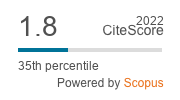Imidazolium supported iron-chloroglycine complex, a good turnover recyclable catalyst for the solvent free synthesis of 3, 4-dihydropyrimidin-2(1H)-ones – promoted by ultrasound irradiation
DOI:
https://doi.org/10.29356/jmcs.v62i3.779Keywords:
Iron(III) complex, Multi-component reactions, Ultrasonication, Ionic liquid, Green aproachAbstract
Abstract. A novel large band gap 1-glycyl-3-methyl imidazolium chloride-iron (III) complex [[Gmim]Cl-Fe(III)] was found to be a heterogeneous catalyst for an efficient and solvent free synthesis of 3,4-dihydropyrimidin-2(1H)-ones by condensation of substituted aldehydes, ethyl acetoacetate and urea (or) thiourea with tremendous yields in high turnover number (4.1X102 to 18.8X102) at ambient temperature using ultrasound irradiation as the activation mode of reaction. This operation formulates very interesting, ecological perspective due to simple reaction condition, isolation and purification of products. In addition, this methodology offers a competitive recyclability of the catalyst without a significant loss of its catalytic activity and could be readily reused, thus making this protocol more environmentally acceptable whilst no catalyst leaching was observed.
Resumen. Se descubrió que un complejo novedoso de banda ancha 1-glicil-3-metilimidazolio cloruro de hierro (III) [[Gmim] Cl-Fe (III)] es un catalizador heterogéneo para una síntesis eficiente y libre de solventes de 3,4- dihidropirimidin-2 (1H) -ones por condensación de aldehídos sustituidos, acetoacetato de etilo y tiourea urea (o) con tremendos rendimientos en alto número de recambio (4.1X102 a 18.8X102) a temperatura ambiente mediante irradiación con ultrasonido como modo de activación de reacción. Esta operación formula una perspectiva ecológica muy interesante debido a la condición de reacción simple, el aislamiento y la purificación de los productos. Además, esta metodología ofrece una reciclabilidad competitiva del catalizador sin una pérdida significativa de su actividad catalítica y podría reutilizarse fácilmente, lo que hace que este protocolo sea más aceptable para el medio ambiente sin que se observe lixiviación del catalizador.
Downloads
References
Kappe, C.O.; Tetrahedron. 1993, 49, 6937.
Welton, T.; Chem. Rev. 1999, 99, 2071.
Karthikeyan, P.; Aswar S.A.; Muskawar, P.N.; Bhagat, P.R.; Senthil Kumar, S.; Catal. Commun. 2012, 26, 189.
Karthikeyan, P.; Arunrao, A, S.; Narayan, M. P.; Kumar, S. S.; Senthil Kumar, S.; Bhagat, P. R.; J. Mol. Liq. 2012, 172, 136.
Karthikeyan, P.; Arunrao, A. S.; Narayan, M. P.; Suresh Kumar, S.; Senthil Kumar, S.; Bhagat, P. R.; J. Mol. Liq. 2012, 173, 180.
Chatel, G.; Goux-Henry, C.; Kardos, N.; Suptil, J.; Andrioletti, B.; Draye, M.; Ultrason. Sono. Chem. 2012, 19, 390.
Singh, V. K.; Ratti, S.; Kad, R; Indian. J. Chem. Sect. B. 2010, 49B, 611.
Bahekar, S. S.; Kotharkar, S. A.; Shinde, D. B.; Mendeleev. Commun. 2010, 14, 210.
Zlotin, S. G.; Makhova, N. N.; Mendeleev. Commun. 2010, 20, 63.
Wang, Q.; Pei, W.; J. Chem. Soc. Pak. 2010, 32, 806.
Ramos, L. M.; Guido, B. C.; Nobrega, C. C.; Correa, J. R.; Silva, R. G.; de oliveira, H. C. B.; Gomas, A. F.; Gozzo, F. C.; Neto, B.A. D.; Chem. Eur. J. 2013 19, 4156.
Priyanka, G. M.; Ratnadeep, S. J.; Deepak, R.N.; Gill, C. H.; Tetrahedron. Let. 2010, 51, 3138.
Zang, H.; Zhang, Y.; Zang, Y.; Cheng, B. W.; Ultrason. Sono. Chem. 2010, 17, 495.
Cella, R.; Stefani, H. A.; Tetrahedron. 2009, 65, 2619.
Yang, Y.; Zhang, Y.; Hao, S.; Kan, Q.; Chem. Eng. J. 2011, 171, 1356.
Rani, S.; Bhat, B. R.; Tetrahedron. Let. 2010, 51, 6403.
Moyer, S. A.; Funk, T. W.; Tetrahedron. Let. 2010, 51, 5430.
Yeung, C. T.; Sham, K. C.; Lee, W. S.; Wong, W. T.; Wong, W. Y.; Kwong, H. L.; Inorg. Chem. Act. 2009, 362, 3267.
Jankowsk, J., Paradowsk, J.; Mlynarski, J.; Tetrahedron. Let. 2006, 47, 5281.
Xie, G., Li, T.; Zhang, A.; Inorg. Chem. Commun. 2010, 13, 1199.
Hatanaka, T.; Miyake, R.; Ishida, Y.; Kawaguchi, H.; J. Organomet. Chem. 2011, 696, 4046.
Chang, L.; Shang, D.; Xin, J.; Liu, X.; Feng, X.; Tetrahedron. Let. 2008, 49, 6663.
Kawatsura, M., Komatsu, Y., Yamamoto, M., Hayase, S.; Itoh, T.; Tetrahedron. Let. 2007, 48, 6480.
Wang, Y., Herron, N., Grushin, V. V., Le Cloux, D., Petrov, V.; Appl. Phys. Let. 2001, 79, 449.
Spadavecchia, J., Ciccarella, G., Siciliano, P., Capone, S., Rella, R.; Sensor. Actuator. B Chem. 2004, 100, 88.
Karipcin, F., Ilican, S., Caglar, Y., Caglar, M., Dede, B., Sahin, Y.; J. Organomet. Chem. 2007, 692, 2473.
Yousef, T. A.; Abu El-Reash, G. M.; El-Gammal, O. A.; Bedier, R. A.; J. Mol. Struct. 2012, 1029, 149.
Shanmuga Priya, R.; Karthikeyan, P.; Mater. Today. Chem. 2016, 1-2, 46.
Karthikeyan, P., Muskawar, P. N.; Aswar, S. A.; Sythana, S. K.; Bhagat, P. R.; J. Mol. Catal. A: Chem. 2013, 379, 333.
Shaabani, A.; Bazgir, A.; Teimouri, F.; Tetrahedron. Let. 2003, 44, 857.
Yu, Y.; Liu, D.; Liu, C.; Luo, G.; Bioorg. Med. Chem. Let. 2007, 17, 3508.
Litvic, M.; Vecenaj, I.; Ladisic, Z. M.; Lovric, M.; Vinkovic, V.; Filipan-Litvic, M.; Tetrahedron. 2010, 66, 3463
Downloads
Published
Issue
Section
License
Authors who publish with this journal agree to the following terms:
- Authors retain copyright and grant the journal right of first publication with the work simultaneously licensed under a Creative Commons Attribution License that allows others to share the work with an acknowledgement of the work's authorship and initial publication in this journal.
- Authors are able to enter into separate, additional contractual arrangements for the non-exclusive distribution of the journal's published version of the work (e.g., post it to an institutional repository or publish it in a book), with an acknowledgement of its initial publication in this journal.









